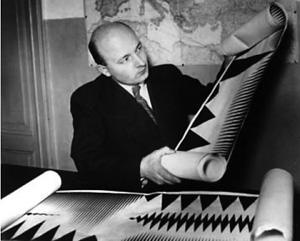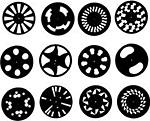contact
MOMus
Museum of Modern Art
Costakis Collection
21 st Kolokotroni Str.
Moni Lazariston
56430, Stavroupoli
Greece
Sound out of Paper |
||
Sound out of Paper is a research project in progress related to the technology of synthesizing sound from light called Graphical (Drawn) Sound technique which was invented in Soviet Russia in 1929 as a consequence of the newly invented sound-on-film technology. At exactly the same time similar efforts were being undertaken in Germany by Rudolf Pfenninger in Munich and, somewhat later, by Oskar Fischinger in Berlin. As such the history of the Graphical Sound is an interesting cross section of 20th century history, reaching from the euphoria of the late 19th Century and early 20th Century inventors through the paradigm-smashing experiments of the Soviet avant-garde in the 1920's and 1930's to the cynical clash of ideologies of the Post-war years and finally to the dawn of the digital era in the 1970's.
This invention came at least twenty years too early while the World War II was already at the threshold. As a result in Soviet Russia by late 1930-s the work in this domain effectively came to a halt. Although there were several short articles in English published in the USA by V.Solev (1935), most publications about research and developments in the USSR were in Russian. At the same time the most important documents were never published at all and were circulating in manuscript form, similar to “Samizdat” (self-published forbidden literature) from the 1960a through the 1980s. In fact almost no information about numerous exiting concepts and inventions related to art and music technology, was translated and published in any foreign language. Fortunately many of those unique archives survived and are collected now at the Theremin Center for Electroacoustic Music in Moscow. Over two hours of synthesized music, produced in 1930s by means of Variophone Synthesizer twenty years before the foundation of electronic music, were discovered recently at the Russian State Film Archive.
Because of the cross-disciplinary nature of the new technique, people involved in it had to be skilled not only in music, but in acoustics, mathematics, sound-on-film technology and engineering. As a result even skilled journalists often could not understand the physical meaning of the phenomena under consideration or specific technological ideas. Having no developed terminology, many mistakes and unexpected “puzzles” appeared in their writings. Moreover, there were several known research groups - competitors working in parallel. It led to a very specific problem – encryption of the information. For instance, in the well-known photograph Oskar Fischinger holds "fake" rolls made by his Studio for publicity purposes since he did not want his competitors to learn his actual technique. Yankovsky used a special cryptographic method to hide his basic technique. To interpret his main puzzle – the only published description of his tools - one has to have the skills of an experienced criminologist. By 1936 there were four main trends of Graphical Sound in Soviet Russia: - Hand drawn Ornamental Sound (Avraamov, early Yankovsky); Although Pfenninger’s curves were not ornaments, and similar to those of Yankovsky, they were rather templates or print-types, forming a sort of sound library; his research deserves to be compared closely with Voinov with his contoured combs, representing halftones as well as Sholpo, with his circular Variophone disc variation on Voinov’s combs.
Of all the early graphical sound pioneers, Yankovsky alone pursued the approach of spectral analysis, decomposition and re-synthesis. As an option there were several sound processing techniques under development in the frame of his spectral approach: pitch shifting, time stretching and a sort of spectral mutation. This method, utilized for time stretching, was mentioned by V.Solev: “After the long intensive work on analysis of the natural phonograms, conducted at the Scientific Research Laboratory at Mosfilm, a problem of time stretching of any sounds, or on the contrary, multiplication of very short sounds (like some consonants), was putted. Herewith is possible to develop analysis and synthesis based on pure drawn sound techniques as well as to apply acoustical approaches, which were discussed in European press. The problem of timbre distortions can be solved now by Yankovsky method of time stretching, using so called “optimal timbrogram” which preserves the timbre of sound“ (Solev 1935). The point was that Yankovsky’s idea was related to independent control over the pitch, volume, duration and tone color on spectral level as well as separation of spectral content and formants, resembling the popular recent computer music techniques of cross synthesis and the phase vocoder. It was certainly the most radical, paradigm-shifting proposition of middle 1930s.
|
||


 The Variophone was developed by Evgeny Sholpo in 1930 at Lenfilm Studio Productions, in Leningrad, the Soviet Union, during his experiments with graphical sound techniques. In his research Sholpo was assisted by the composer Georgy Rimsky-Korsakoff (the grandson of the famous composer N.A. Rimsky-Kosakoff ) .
The Variophone was developed by Evgeny Sholpo in 1930 at Lenfilm Studio Productions, in Leningrad, the Soviet Union, during his experiments with graphical sound techniques. In his research Sholpo was assisted by the composer Georgy Rimsky-Korsakoff (the grandson of the famous composer N.A. Rimsky-Kosakoff ) .  The Variophone was an optical synthesizer that utilized sound waves cut onto cardboard disks rotating synchronously with a moving 35mm movie film while being photographed onto it to produce a continuous soundtrack. Afterwards this filmstrip is played as a normal movie by means of a film projector. Being read by photocell, amplified and monitored by a loudspeaker, it functions as a musical recording process.
The Variophone was an optical synthesizer that utilized sound waves cut onto cardboard disks rotating synchronously with a moving 35mm movie film while being photographed onto it to produce a continuous soundtrack. Afterwards this filmstrip is played as a normal movie by means of a film projector. Being read by photocell, amplified and monitored by a loudspeaker, it functions as a musical recording process.